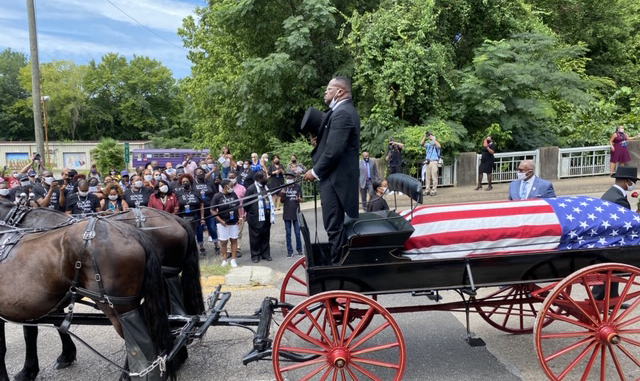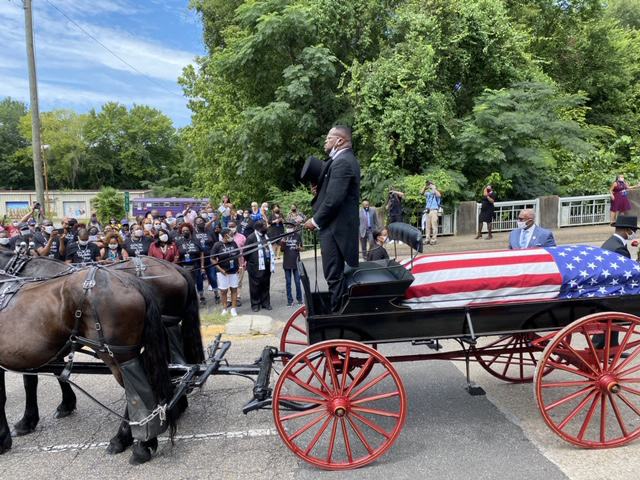
By Connie F. Smith-Lindsey,
Guest Contributor,

Oh Freedom, Oh Freedom
And before I’ll be a slave
I’d be buried in my grave
And go home to my lord and be free
From Brown Chapel A.M.E. Church to the Edmund Pettus Bridge and then on to Montgomery.
I stood on top of two tall steel barriers at the base of the Edmund Pettus Bridge to watch history of the horse-drawn caisson with the late Congressman John Robert Lewis. The national media and spectators were positioned with their cameras pointed toward the bridge to capture the historic moment of Lewis crossing the Edmund Pettus Bridge one more time.
At exactly 11 a.m. (CST), organizers and members of the media sprinted toward us as if to summon all the witnesses. We were gazed on history. Then the moment arrived and we counld see the horse-drawn caisson with the flag draped casket bearing the body of the Honorable Congressman John Robert Lewis as it reached the apex of the bridge. Gabriel’s trumpet and orchestra were playing in heaven as the cloud of witnesses stood up. Spectators offered freedom songs, praises of thanks to God, clapping and waving of hands. Some spectators sobbed. This was far from the image of Bloody Sunday in 1965.
There was a deep sadness with the appearance of his casket for the first-time. I found strength in a familiar cadence with words that flowed with ease to commemorate my hometown hero:
“Congressman John Lewis crosses the Edmund Pettus Bridge one more time. This solemn ceremony culminates the work of a great man. A man who started out with humble beginnings, but by the grace of God he saved a nation and a world. Congressman John Lewis crosses the Edmund Pettus Bridge one more time. This time he is not bloodied, he is not bowed, he is not down. But instead, he is in the bosom of his Lord.”
The horse-drawn carriage, driven by Darrell Watkins of Willie A. Watkins Funeral Home, was like a processional for a close family member.
My words came from years of watching Congressman Lewis represent the 5th Congressional District in Atlanta, attending worship services and revivals as a member of the historic Ebenezer Baptist Church, attending over two decades of the Annual Martin Luther King Jr. Commemorative Service at the King Center in Ebenezer and the dedication of the Martin Luther King Memorial in D.C., to name a few.
In a recent prayer service to get our hearts ready to vote, Lewis asked the church to sing a freedom song as he talked about the sacredness of the vote. He said, “About now, Dr. King would ask us to sing a freedom song. We need a freedom song right now.” I watched him move in the spirt that night from the balcony.
There is also the memory of standing at the altar on election night in 2008 awaiting the results of the presidential election. Lewis was elated before they declared Barack Obama the winner. We witnessed history of the first African-American president reaching this milestone. Our ancestors prayed that we would not give up in adversity to not only build the White House but someday live there as First Family. This moment brought Lewis to tears and jubilation.
One more memory stands out as this horse-drawn caisson crosses over the Edmund Pettus bridge. On Sunday, February 28, 1999, youth presented a conversation with Lewis and Coretta Scott King as part of the Black Heritage Tribute in Heritage sanctuary at Ebenezer. This is the sanctuary where Dr. King preached “The Drum-Major Instinct” and “A Knock at Midnight.” I prepared our youth with scripts and stories of two of my freedom fighters. As I reflect on my director’s notes, Lewis was in the congregation that Sunday and watched his story portrayed by Sean Seay, who stood in the giant’s shoes on the worship services. Lewis commended Seay on his performance. Like most Black History moments, Lewis and King reminiscence about pivotal moments – life and death – in their fight against injustices.
Bloody Sunday through the eyes of the John Lewis
“We marched down Water Street, turning right and walking along the river until we reach the base of the Edmund Pettus Bridget. There were armed white men everywhere. They had hard hats on their heads and clubs in their hands. Some of them were smirking. One of the officers shouted out: This is an unlawful assembly. Your march is not conducive to the public safety. You are ordered to disperse and go back to your church or to your homes. We weren’t about to turn around and run. The officer said, “You have two minutes to turn around and go back to your church.” We couldn’t go forward and we couldn’t go back. We decided to kneel and pray. Before we could pray, the troopers were everywhere, swinging their clubs, riding horses over fallen people, shouting racial slurs and obscenities. A large, husky trooper swung his club against the left side of my head. I didn’t feel any pain, just the thud of the blow, and my legs giving way. I raised an arm as I curled up in the ‘prayer of protection’ position. And the trooper hit me again. I was bleeding badly. My head was now exploding with pain.”
Fought a good fight, finished his course, and kept the faith
Bloody Sunday was over 55 years ago and there is a new narrative today. We must cross the bridges that deny human rights and civil rights in America and world.
John Robert Lewis crossed what was once a barrier to freedom. But God has the final word. Lewis won one of the battles for freedom with love and non-violence to destroy hate.
5th Principle of Nonviolence
Lewis and others could have lost their lives and limbs and even minds with the beatings. They practiced Dr. King’s Fifth Principle of Nonviolence:
Nonviolence chooses love instead of hate. Nonviolence resists violence to the spirit as well as the body. Nonviolence love is active, not passive. Nonviolence love does not sink to the level of the hater. Love restores community and resists injustice. Nonviolence recognizes the fact that all life is interrelated.
Bloody Sunday could have defeated freedom fighters and freedom riders with the amount of bloodshed, beatings, lynchings and human indignities, but they returned with a unflinching determination to finish the race, to march, to sit in and to go to jail together to change the injustices against black and brown people. Freedom fighters and freedom riders showed up in cities and places to challenge segregation and voter suppression. Some died. Some marched on.
The unrest in Selma and across American moved President Lyndon B. Johnson to sign the Voting Rights Act of 1965.
Red rose petals
Organizers commemorated the historic crossing with beautiful red rose petals – symbolic of the blood that Lewis and others shed on the bridge. The red roses moved freely across the bridge to show that love wins over hate. Many spectators young and old picked up the crushed roses. Generations have a piece of history that is transformative. Funeral Director Willie A. Watkins emerged from the black hearse with platinum and presented red long-stemmed roses to some spectators. Love wins over hate.
His siblings
Lewis preached to the chickens on his family farm and those sermons gave them a special family bond. His siblings speak fondly of their brother – Robert, as affectionately called by them. He is their beloved brother but also a childhood pastor. They were Lewis’ first congregation.
From all walks of life
Spectators lined the streets and carried messages of “Good Trouble” “Black Lives Matters” “Nah” as reminders that we must work in harmony to create the Beloved Community. As God ordained, the fluffy clouds rested just above our heads bringing relief during the ceremony from Selma’s dry, scorching heat. Regardless of the weather, no obstacle was too big or too small to keep me from the Edmund Pettus Bridge on this day.
From Selma to Montgomery
With sirens blasting and rapid flashing blue lights, the Montgomery police led the motorcade on that historic 54 miles to Montgomery. As we reflect on the full circle of history of the Selma to Montgomery March, we know God orchestrated “Bloody Sunday” and used it for His good and good of His children.
Young warriors pick up the mantle for freedom
The curtain closes on Lewis’ God-centered life. He leaves a legacy for young activists to march in the streets with their fists raised toward heaven. They are the sons and daughters of sharecroppers, immigrants and families who may have once owned slaves. Change has come with this new generation. Lewis passes the mantle to keep fighting and keep pushing for change – against system racism, the need for police reform to stop the killings of black bodies in the streets by police and from gun violence. As we wade in the water toward another presidential election, this election is pivotal, and we must remove all acts of voter suppression and educate our children and their children that voting is sacred. Young warriors go get in good trouble for justice.
“You must never give up. You must never give in.”
On Thursday, July 30, 2020, the Honorable John Robert Lewis will be laid to rest in Atlanta, Georgia. This mighty warrior is victorious one more time.
Goodnight, mighty warrior. We will keep marching and getting in “good trouble.”
Connie F. Smith-Lindsey is a Spelman College alumna. She is a storyteller and producer of historic moments about freedom fighters from the civil rights era. She lives in Atlanta, Georgia.
See photos on page 22 and view video on www.themississippilink.com.

Be the first to comment